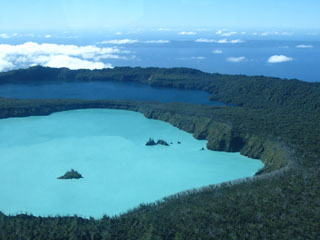Report on Ambae (Vanuatu) — May 2013
Bulletin of the Global Volcanism Network, vol. 38, no. 5 (May 2013)
Managing Editor: Richard Wunderman.
Ambae (Vanuatu) Minor activity likely continuing into early 2013
Please cite this report as:
Global Volcanism Program, 2013. Report on Ambae (Vanuatu) (Wunderman, R., ed.). Bulletin of the Global Volcanism Network, 38:5. Smithsonian Institution. https://doi.org/10.5479/si.GVP.BGVN201305-257030
Ambae
Vanuatu
15.389°S, 167.835°E; summit elev. 1496 m
All times are local (unless otherwise noted)
In our May 2011 Bulletin we reported that there was increased degassing at Aoba (also known as Ambae) starting December 2009 through at least April 2010. This report summarizes notices pereiodically posted by the Vanuatu Geohazards Observatory (VGO) and covers the time interval from 4 June 2011 through 26 February 2013. The Vanautu Volcano Alert Level (VVAL) remained at 1 (on a scale of 0-4.)
Observations on 4 June 2011 revealed that small explosions had been occurring from the crater lake and were accompanied by local ashfall around the crater. Some villagers in the N and W parts of the island had observed the explosions.
Based on analysis of data collected by the Vanuatu Meteorology and Geohazards Department (VMGD), the Vanuatu Geohazards Observatory reported that a small series of explosions from Aoba occurred on 10 July 2011. On July 11, VGO noted that there had been recent increases in activity from Ambae and that local earthquakes were volcanic. Satellite images collected by the Ozone Monitoring Instrument showed sulfur dioxide emissions. Photos showed that the volcano was quiet on 12 July 2011, although ongoing earthquakes were detected.
According to the VGO, Ambanga villagers reported that minor activity at Aoba began in December 2012. The OMI instrument detected strong gas emissions on 18 and 25 January 2013; the emissions continued at a lower level through 7 February. Field observations by the Geohazards team during 30 January-2 February 2013 confirmed that activity had significantly changed. Data retrieved from a monitoring station also confirmed ongoing activity. Satellite images acquired on 3 and 26 February 2013 detected substantial sulfur dioxide emissions.
No MODVOLC Thermal Alerts were issued in the previous year ending 16 July 2013.
Geological Summary. The island of Ambae, also known as Aoba, is a massive 2,500 km3 basaltic shield that is the most voluminous volcano of the New Hebrides archipelago. A pronounced NE-SW-trending rift zone with numerous scoria cones gives the 16 x 38 km island an elongated form. A broad pyroclastic cone containing three crater lakes (Manaro Ngoru, Voui, and Manaro Lakua) is located at the summit within the youngest of at least two nested calderas, the largest of which is 6 km in diameter. That large central edifice is also called Manaro Voui or Lombenben volcano. Post-caldera explosive eruptions formed the summit craters about 360 years ago. A tuff cone was constructed within Lake Voui (or Vui) about 60 years later. The latest known flank eruption, about 300 years ago, destroyed the population of the Nduindui area near the western coast.
Information Contacts: Vanuatu Geohazards Observatory (URL: http://www.vmgd.gov.vu/vmgd/); and Hawai'i Institute of Geophysics and Planetology (HIGP), MODVOLC Thermal Alerts System, School of Ocean and Earth Science and Technology (SOEST), Univ. of Hawai'i, 2525 Correa Road, Honolulu, HI 96822, USA (URL: http://modis.higp.hawaii.edu/).

